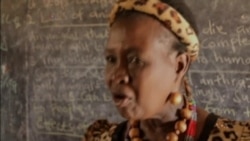Malawi has one of the world's highest rates of child marriage. Half of girls wed before their 18th birthday and nearly one in eight is married by 15. One person, known as Chief Kachindamoto, has been on a mission to reverse that trend.
Chief Kachindamoto
She’s managed to break up 850 marriages involving children under the age of 18 in Malawi. She says nothing makes her happier than seeing some of the former child brides back in school. "I tried my best to see these girls to be a lot in classes. So, as you can see, indeed, I am a happy chief."
A hereditary tribal chief, Kachindamoto left her longtime job as a secretary to lead 900,000 people in central Malawi's Dedza district 13 years ago. In a country where child marriage is deeply entrenched in society, the chief has had a difficult, but not impossible, task.
"There’s [are] mother groups and we have these community policing, child protection workers who are going out looking at each and every house to follow these children," she expressed.
Former child brides’ stories
Judith Kabango was married at 14 and has a four-year-old son. Kabango's marriage was annulled after chief Kachindamoto, while carrying out a door-to-door campaign, found her working in a maize field during school hours. She has since gone back to school at age 18. “I wasted valuable time,” Kabango says “but now I am in full-time learning and making a future for me and my child."
Stories like Kabango's are similar to those of countless girls in Malawi. Via Skype, Joyce Mkandawire told VOA the story of Josephine. Mkandawire is Malawi country coordinator for Rise Up, an umbrella organization that unifies many groups including Let Girls Lead, Champions for Change and the Youth Champions Initiative, to benefit millions of girls, youth and women globally.
“At 15 years old she has two children. This girl was married off at 12 years old and the reason why, according to her, is because of poverty and because she lost her parents to HIV/AIDS. There is no one literally to support her.” Mkandawire also points out that Josephine complained bitterly about being beaten and abused by her former husband, who also had another wife.
“You can just imagine a girl at 15 telling you she has to look after her two children when she is a child herself,” Mkandawire recalls. With her organization’s help, Josephine is now back in school, but the impact she says is that by the time girls like Josephine turn 18 they’ve already had three or four children, having started child-bearing so early.
New law versus Constitution
Following advocacy efforts by civil society and people like Mkandawire and Chief Kachindamoto, the country’s parliament last year passed a law raising the minimum marrying age to 18. However, according to Lyric Thompson of the International Center for Research on Women, the new law may be in conflict with Malawi's constitution.
“My understanding is that the constitution itself still allows for parental consent under the age of 18. So we see this in many countries where there's a tension between the letter of the law and the constitution saying one thing, a piece of national legislation saying another thing, and then customary or Tribal Law saying another thing altogether. And then the question is, how did these pieces fit together? The constitution is the law of the land. That does need to be amended in order to be in harmony with the new legislation.” Mkandawire echoes that sentiment. While she championed the passing of the law, she also says it’s a challenge that it’s in English while most of the girls directly affected speak Chichewa, the local language. And “in the deep parts of the rural areas, judges are not even aware of the law because they haven’t been civically educated, and they end up just using the constitution which is the law of the land,” she adds.
Thompson also says it’s important to invest in dismantling the root causes, including poverty and gender inequality. “Taking the economic issues that are driving parents to say, 'you know what, I can only afford for one child to go to school. Am I going to send my boy who's going to come back and reinvest in my family or my girl who’s probably just going to get married off at some point? No, let me send the boy.' These are decisions that families are making every day that are based in their own realities and are not because they don't care about their girls.”
Across the globe, according to UNICEF, rates of child marriage are highest in South Asia, followed by sub-Saharan Africa.










